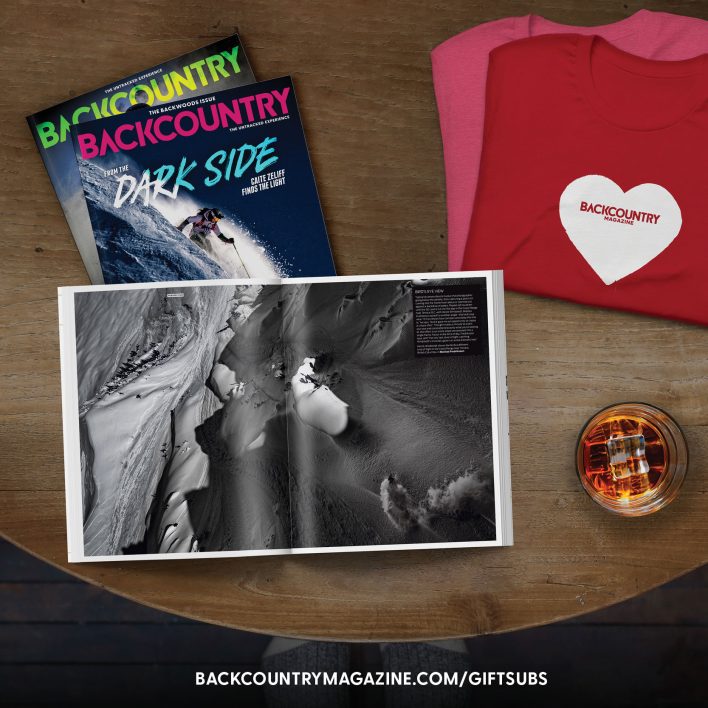Picture this: You’re skiing across low-angle terrain, but need to traverse below a steep open face with no cover. Your avalanche awareness bells start chiming, “Danger!” so you decide to ski out of your way to remain clear of the possible slide path. But there are no trees around to give clues about where you’ll be safe if it slides. So how far is “far enough” from the suspect slope? The concept of “alpha angle” or “runout angle” can help you answer that question.
How Far Can That Avalanche Go?
Alpha angle is the incline of an imaginary line drawn between the start zone of a slide (its crown, or highest point) and the farthest toe of the resulting debris field. Alpha angles for “100 year” avalanches (i.e. the big ones) are typically in the 18- to 20-degree range, depending on the specific mountain range and other factors. Unless you have site-specific data showing otherwise, assuming a slide will go no farther than 18 degrees in a runout is generally the safe bet.

In the above illustration, it’s easy to see that you’re much better off in position “A” than in position “C” if the slope were to slide. But how do you know where you are in relation to alpha angle?
Alpha Angle vs. Slope Angle
Before we get into the details of applying alpha angle, it’s worth pointing out the distinction between alpha angle and slope angle. Both can be called on to help make informed decisions in avalanche terrain, but they tell us very different things. Slope angle—the inclination of the surface of the snow—can help you answer the question, “Could this slope slide?” Alpha angle can help you answer “Am I far enough from that slope to be safe if it does slide?”
We can measure both alpha angle and slope angle using the same type of instrument: an inclinometer.
What is an Inclinometer?
An inclinometer (a.k.a. clinometer or slope meter) is a device for measuring angles relative to a horizontal plane. In backcountry skiing, inclinometers are commonly used to measure slope angle. There are many different ways to measure slope angle with an inclinometer, but they mostly fall into one of three categories:
Contact Measurement: Rest the inclinometer directly on the surface of the snow, or on a ski pole on the surface of the snow.
Profile Measurement: Sight the profile of a slope when viewing it from the side, often from a distance to eyeball the slope angle.
Line-of-Sight Measurement: Look up or down a slope so your line of sight matches the surface of the slope. This is where alpha angle comes into play.
Some models of inclinometer allow measurements by all three of these common use modes. Others only support one or two. Each of the three has its applications in slope angle measurements for backcountry skiing.
Inclinometers for Alpha Angle
Alpha angle assessments require line-of-sight measurement mode. But you’re not measuring surface angle anymore; you’re sighting the angle of an imaginary line between you and a distant “target” (the avalanche crown, or the top of the suspect slope). You can’t do that with most inclinometer phone apps or pocket inclinometer cards, which only work for contact and profile measurement modes. And there are a few devices available that do work well for alpha angle assessments—and other line-of-sight measurements. One option is the Suunto PM-5 clinometer, but there are also many mirror-equipped compasses with a built-in clinometer feature, such as the Silva Ranger or Suunto MC-2 series. Check out the following diagram to see what these look like when sighting for alpha angle:

With both devices, your sighting “target” is the highest possible start zone of the suspect avalanche path. If you measure greater than 18 degrees of inclination to that point, then you could be in the firing line if a big slide lets go. If you get a reading of less than 18 degrees, you can be fairly confident you will be clear of even the biggest slide from the slope in question.
PoleClinometer: The “Quick Draw” Option
A newer product in the inclinometer world is the versatile and light-weight PoleClinometer ski pole inclinometer sticker kit. It’s little more than a sticker you put on your ski pole, but it allows incredibly quick—because it’s always in your hand—and surprisingly accurate, inclination measurements. New for the 2016/2017 season is a dedicated alpha angle feature. Check out points “C” and “A” in the diagram below to learn what it looks like when sighting for alpha angle with a PoleClinometer in the diagram.

To use the alpha angle feature, target a point at the top of a suspect slope, and dangle your pole so the red “18-degree line” on the sticker is in line with that point. The perceived shape of that line indicates if you’re closer or farther than 18 degrees from your sighting target. Reading the red line is easy: If it’s “frowning” (i.e. curved down) you’re closer than 18 degrees and could be vulnerable to a big slide. If it’s “smiling” (i.e. curved up) you’re farther than 18 degrees and should be clear of any slide from that slope.
Bottom Line: Obviously, alpha angle is not going to tell you everything you need to know to stay safe in the mountains, but it’s certainly a useful tool to add to your quiver for when you venture into avalanche terrain. Applying the rule of 18 degrees could be the difference between a fun day in the mountains and a multiple burial situation.
More on Alpha Angle
If you’d like more insights on the use of alpha angle in backcountry skiing, Lou Dawson offers an in-depth discussion in this WildSnow article, “Alpha Angle — How Far Can that Avalanche Go?”
And Bruce Tremper has a section on runout angle in his excellent book, “Staying Alive in Avalanche Terrain.”
—
Grayson King is an engineer and longtime weekend-warrior backcountry ski junkie. After discovering the powerful role of inclinometers in avy safety, he invented PoleClinometer in an effort to make slope-angle measurements quicker and easier for everyone.











Related posts:
A Goal of Zero: The Avalanche Industry Looks To Change
MOUNTAIN SKILLS: TIPS FOR CLEAR COMMUNICATION
Mountain Skills: Understanding The Extended Column Test
Food Fight: Can What You Eat Earn You Another Lap Up The Skintrack?